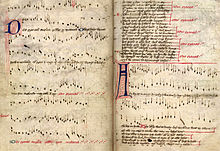This is another classic example in which "modern" orchestral instruments are used to fine effect by Sir William Walton in the famous film of Henry V starring Olivier. It is directly based on the Argincourt Carol.
https://www.youtube.com/watch?v=nvFY93WBPPY
The Medieval interpretation of the Argincourt Carol appears in the following Wikipedia article near the end
From Wikipedia, the free encyclopedia

Facsimile of the Oxford version of the Agincourt Carol (15th century). Oxford, Bodleian Library, Manuscript Archives.
The carol is featured in Laurence Olivier's 1944 film Henry V.[2]
Lyrics[edit]
- Deo gratias Anglia redde pro victoria!
- [Give thanks, England, to God for victory!]
- Owre Kynge went forth to Normandy
- With grace and myght of chyvalry
- Ther God for hym wrought mervelusly;
- Wherefore Englonde may call and cry
- Chorus
- Deo gratias!
- Deo gratias Anglia redde pro victoria!
- He sette sege, forsothe to say,
- To Harflu towne with ryal aray;
- That toune he wan and made afray
- That Fraunce shal rewe tyl domesday.
- Chorus
- Then went hym forth, owre king comely,
- In Agincourt feld he faught manly;
- Throw grace of God most marvelsuly,
- He had both feld and victory.
- Chorus
- Ther lordys, erles and barone
- Were slayne and taken and that full soon,
- Ans summe were broght into Lundone
- With joye and blisse and gret renone.
- Chorus
- Almighty God he keep owre kynge,
- His peple, and alle his well-wyllynge,
- And give them grace wythoute endyng;
- Then may we call and savely syng:
- Chorus[3]
The Agincourt Carol was recorded by The Young Tradition on Galleries, (with both the Early Music Consort and Dave Swarbrick contributing), and by the Silly Sisters (band) (Maddy Prior and June Tabor) on their second album No More to the Dance.
External links[edit]
- Agincourt carol sheet music
- IMSLP
- Medieval primary sources
- YouTube Interpretation by The Young Tradition (Peter Bellamy. Royston Wood, Heather Wood), with David Munrow on shawm, Roddy and Adam Skeaping on viols, and Christopher Hogwood on percussion.
References[edit]
- Jump up ^ BBC Music, Christmas 2011
- Jump up ^ "Soundtracks for "The Chronicle History of King Henry the Fift with His Battell Fought at Agincourt in France"". IMDb entry for "The Chronicle History of King Henry the Fift with His Battell Fought at Agincourt in France" (1944). Internet Movie Database. Retrieved 2007-04-19.
- Jump up ^ "Der Hundertjährige Krieg: Der sogenannte "Agincourt Carol"". Abteilung für Mittelalterliche Geschichte der Universität Tübingen. Universität Tübingen. Retrieved 2007-04-19.
- Jump up ^ Roden, Timothy; Wright, Craig; Simms, Bryan (2010). Anthology for Music in Western Civilization 1. Boston, MA: Schirmer. p. 41. ISBN 978-0-495-57274-9.
|




No comments:
Post a Comment